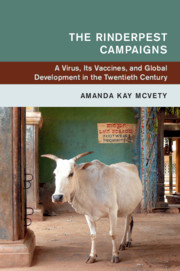Book contents
- The Rinderpest Campaigns
- Global and International History
- The Rinderpest Campaigns
- Copyright page
- Dedication
- Contents
- Figures
- Acknowledgments
- Abbreviations
- Introduction Grosse Île, September 1942
- 1 Rinderpest and the Origins of International Cooperation for Disease Control
- 2 GIR-1: Rinderpest in World War II
- 3 “Freedom from Want”: UNRRA’s Rinderpest Campaigns
- 4 The Machinery of Development: FAO’s Rinderpest Campaigns
- 5 Back to Grosse Île: Biological Warfare in the Postwar World
- 6 “Freedom from Rinderpest”
- Conclusion
- Select Bibliography
- Index
- References
Select Bibliography
Published online by Cambridge University Press: 13 August 2018
- The Rinderpest Campaigns
- Global and International History
- The Rinderpest Campaigns
- Copyright page
- Dedication
- Contents
- Figures
- Acknowledgments
- Abbreviations
- Introduction Grosse Île, September 1942
- 1 Rinderpest and the Origins of International Cooperation for Disease Control
- 2 GIR-1: Rinderpest in World War II
- 3 “Freedom from Want”: UNRRA’s Rinderpest Campaigns
- 4 The Machinery of Development: FAO’s Rinderpest Campaigns
- 5 Back to Grosse Île: Biological Warfare in the Postwar World
- 6 “Freedom from Rinderpest”
- Conclusion
- Select Bibliography
- Index
- References
- Type
- Chapter
- Information
- The Rinderpest CampaignsA Virus, Its Vaccines, and Global Development in the Twentieth Century, pp. 254 - 277Publisher: Cambridge University PressPrint publication year: 2018



